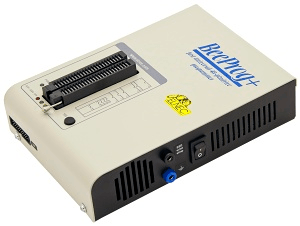Device Programmers Information
 Device programmers are used to program nonvolatile memory, such as microcontrollers, EPROMs, PLDs, PALs, GALs, and other electrically programmable devices. The programmable device is inserted into a socket on the device programmer and its memory buffer content is transferred into the programmable device.
Device programmers are used to program nonvolatile memory, such as microcontrollers, EPROMs, PLDs, PALs, GALs, and other electrically programmable devices. The programmable device is inserted into a socket on the device programmer and its memory buffer content is transferred into the programmable device.
Features
Programmer types for device programmers can be stand-alone workstation, computer controlled, or production unit. Device capabilities include single-socket programming, gang, or set programming, in-circuit programming, eraser, and SIMM and DIMM tester. Single socket programmers are used to program one device at a time. Gang or set programmers are used to program several devices simultaneously. A gang programmer can program several devices with the same data for all devices. A set programmer can program several devices with different data for each device. In-circuit programmers are used to program chips already installed in computer systems, without the need to unplug the chip. Erasers are chip erasers, such as EPROM Eraser or EEPROM Eraser. SIMM and DIMM testers are used to test memory chips of the type Single In-line Memory Module (SIMM) or Dual In-line Memory Module (DIMM).
Types
Devices supported by device programmers can be one of many types. These include:
- Complementary Metal Oxide Semiconductor (CMOS)
- Programmable Read-Only Memory (PROM)
- Bipolar Programmable Read-Only Memory (BPROM)
- Erasable Programmable Read-Only Memory (EPROM)
- Electrically Erasable Programmable Read-Only Memory (EEPROM)
- FLASH
- Programmable Logic Device (PLD)
- Erasable Programmable Logic Device (EPLD)
- Complex PLD
- Programmable Array Logic (PAL)
- Generic Array Logic (GAL)
- microcontrollers
- PIC series of microcontrollers
Specifications
Important device performance specifications to consider for device programmers include number of pins, number of sockets, memory buffer, and file format supported. The number of pins is the maximum number of pins supported. The number of sockets is the number of devices that can be programmed in parallel. The memory buffer is the amount of memory embedded in the programmer. It is used to temporarily store the programmer output. File formats that can be supported include Intel Hex, Intel Extended Hex, Intel 32-bit Hex, Motorola S-Record, binary, JEDEC, ASCII, and POF.
Standards
Some device programmers conform with the American requirements of the Federal Communication Commission (FCC) and with the European CE Marking system, which is helpful for exports to the countries of the European Economic Area (EEA). Operating humidity and operating temperature are important environmental operating conditions to consider.
Related Information
CMOS Image Sensors, Memories Lead the Way in 3D Chip Technology
IEEE Spectrum—Interactive: The Top Programming Languages 2016
IEEE Spectrum—In Your Pocket: Smartcards
Image credit:
Pssstpssst / CC BY-SA 3.0
- ASCII
- Binary
- CE / FCC Certified
- CMOS
- CPLD
- Computer Controlled
- DOS
- EEPROM
- EPLD
- EPROM
- Eraser
- FLASH
- Flash, SRAM-based FPGA
- In-circuit Programmer
- Intel® 32-bit Hex
- Intel® Hex
- JEDEC
- Microcontrollers
- Motorola® S-Record
- Multi-site Programmer / Gang Mode
- Multi-site Programmer / Set Mode
- PALs
- PIC
- PLD
- POF
- PROM
- Production Unit
- Single-site Programmer
- Software Updates
- Stand-alone Workstation
- Warranty
- Windows® 2000
- Windows® 95
- Windows® NT
- Windows® XP
- Windows® 98
- programmer 2716
- EEPROM PLCC programmer
- Flash Memory Programmer
- universal device programmers
- 2732 EPROM programmer
- compact flash gang programmer
- microcontroller programmer
- multi pic programmer schematic
- 24c04 EEPROM programmer kit
- BDM programmer
- EEPROM 24c02 programmer
- EEPROM programmer circuit
- EPROM burner
- Flash Programmer
- I2C programmer
- intel 27c64 programmer
- m95160 programmer
- NAND flash programmer
- pic programmer schematic PCB
- programmer JDM
- simple programmer at89c2051
- taiko device
- universal programmer schematic
- USB SPI flash programmer
- willem EPROM programmer
- CMOS PLD programmer
- microcontroller programming kit
- flash device programmers
- FPGA device programmers
- serial device programmers
